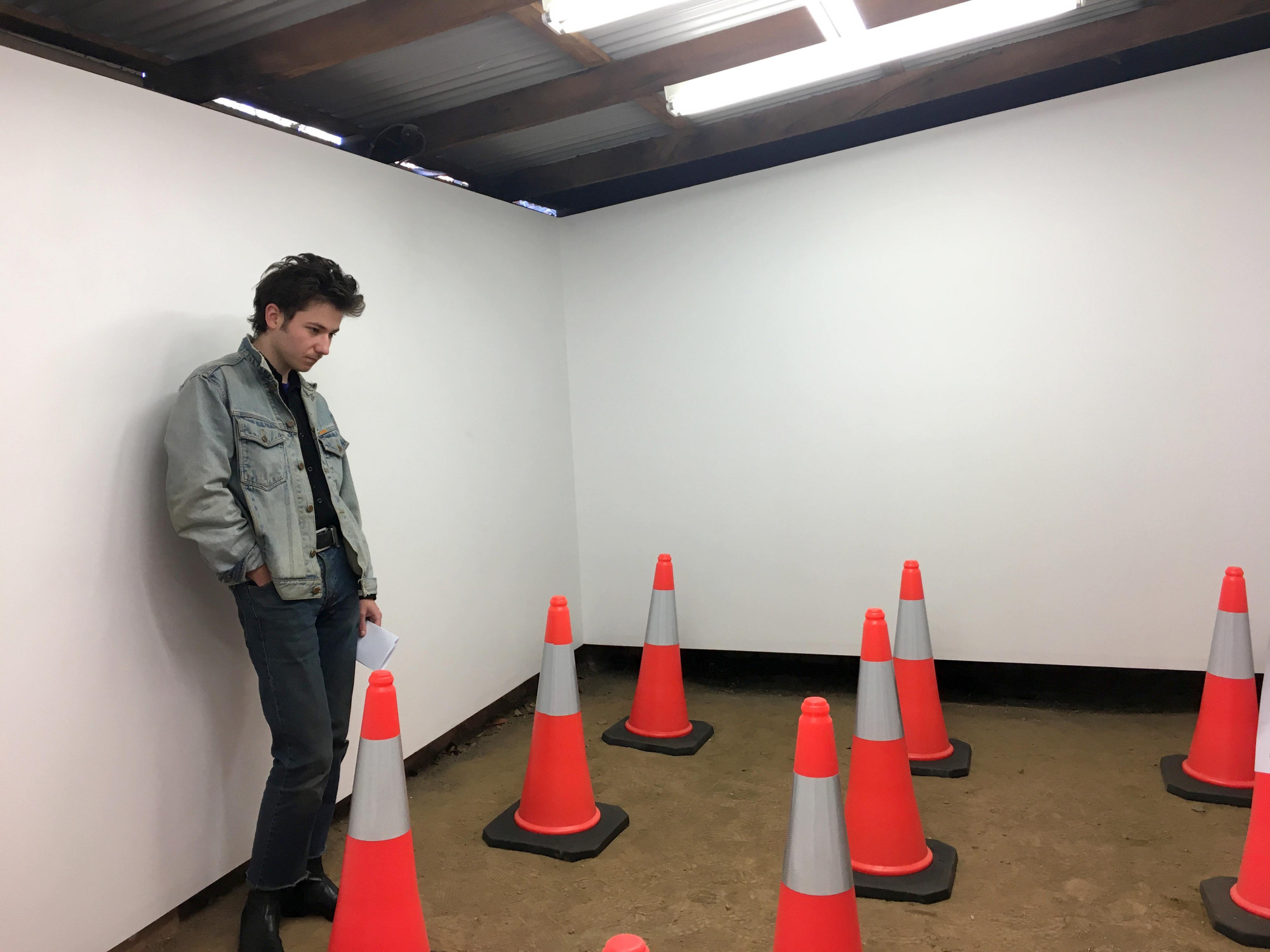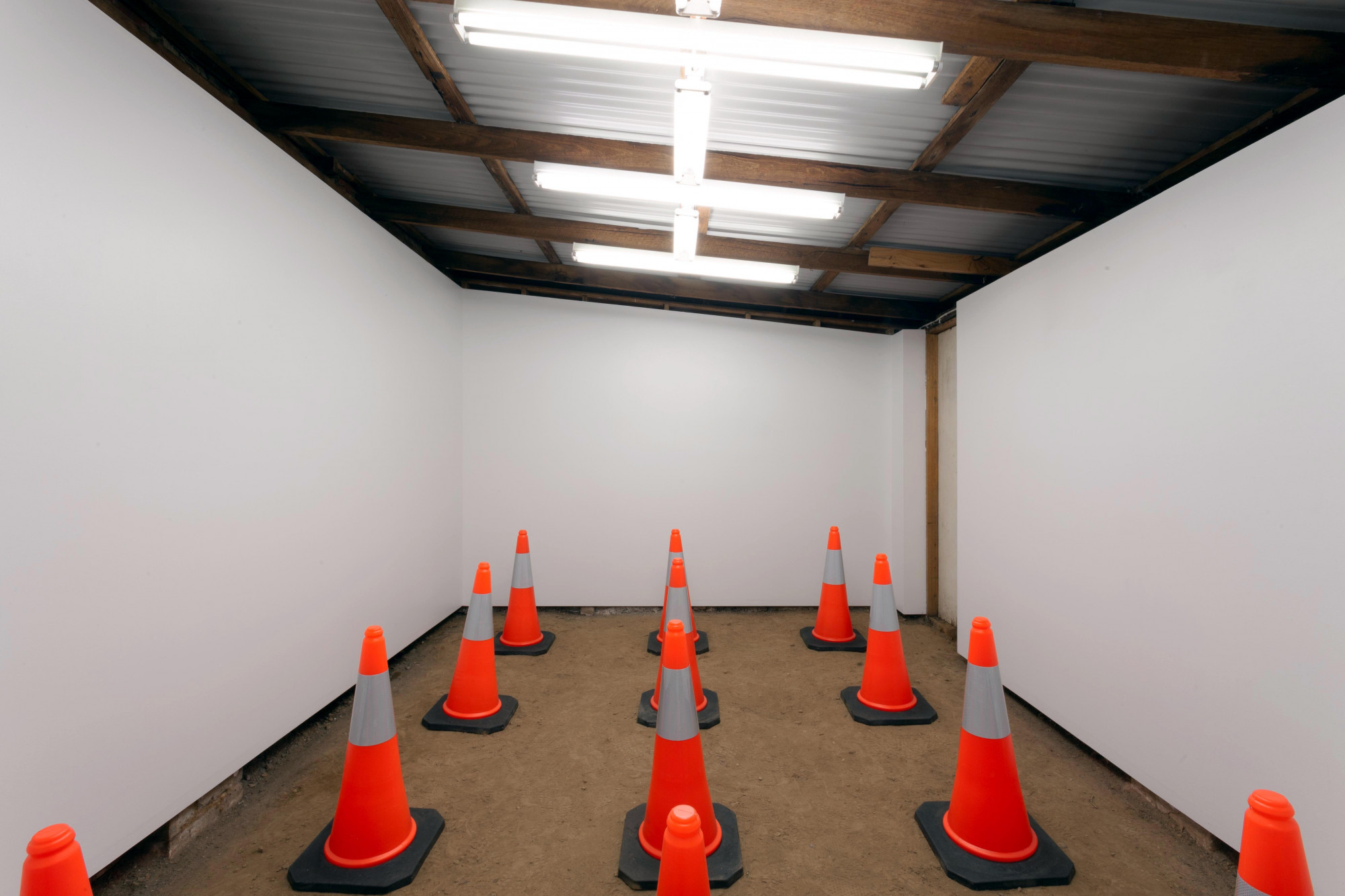Merlin Carpenter, Room Based
Vincent Le
Room Based is Merlin Carpenter’s first Australian solo exhibition at Guzzler, curated by David Homewood, Luke Sands and Alex Vivian out of their Rosanna share house. In their small backyard shed turned meticulously white-walled but still dirt-floored gallery, they have faithfully followed Carpenter’s managerial orders to fill the space with fifteen European-style orange and silver traffic cones purchased out of their own pocket in a five by three symmetrical arrangement.
It’s always a bit of a journey in itself getting to Guzzler. For most people in attendance at Room Based’s opening, it involved organising carpools or catching multiple buses and trains. In my case, it meant nursing a hangover from the Friday night before, hitching a last-minute ride and making a refreshing pitstop at a Rosanna tapas bar for cocktails before arriving at the destination. But since Carpenter’s “network painting” has been rather influential on many of Melbourne’s self-styled enfant terrible artists like Hamishi Farah and Zac Segbedzi, whose work also trolls its own spectators and socio-cultural environs, there was an unusual amount of excited conversations and eager anticipation leading up to the show as something that simply couldn’t be missed.
Given the not insignificant first-world effort it took to get to Room Based, one cannot help but feel disappointed by the work itself: a symmetrical circuit of everyday, run-of-the-mill traffic cones. But, of course, disappointment is something that Carpenter has long trafficked in like a drug dealer selling those diluted Netflix-stamped ecstasy pills. Like many of his readymades and paintings, the traffic cones are formally devoid of beauty in a way that seems to largely sideline the work’s aesthetic dimension or lack thereof. To focus on directly and clinically describing this work, however fastidiously, would be to overlook a crucial dimension of the work itself. Instead, Carpenter has turned the means of artistic and economic production—in this case, the hype building up to the show—into an end in itself. The hype around Room Based is a hype of nothing, what Carpenter calls in the room sheet “the work that is not the work”. This simulacrum of a great show envisions marketing as neither the purely perfunctory means of promoting art nor the death of art when the will to promote is taken too far; it is marketing as a complete artwork in and for itself. Not a hyperstitional fiction that makes itself real upon arrival, but a reverse hyperstition; a reality that makes itself fiction. A kind of sunk cost fallacy or Stockholm syndrome.

Since all the enthusiastic chatter and curiosity preceding the show turned out to be a hype of nothing but that very hype itself, my attention at the opening soon turned to the typical drinks and socialisation. Room Based’s underwhelming traffic cones that seem to prohibit engagement and even entry into the quarantined gallery space described precisely as a “virus” in the room sheet redirect us around the opening itself as another means of presenting art—and in more commercial galleries of selling it—which here becomes an end unto its own, or what David Joselit calls “painting beside itself”. This tactic is not dissimilar to Carpenter’s Paint-It-Yourself exhibition last year at Reena Spaulings Fine Art, New York where the opening attendees were presented with blank canvases and paint to create the works themselves. Having been an assistant to pioneer of proto-institutional critique Martin Kippenberger in Cologne during his formative years, Carpenter pursues his former master’s claim that “simply to hang a painting on the wall and say that it’s art is dreadful. The whole network is important! Even spaghettini … When you say art, then everything possible belongs to it. In a gallery that is also the floor, the architecture, the colour of the walls”. Not to mention everything in between, from the promotion for the show to the opening social intoxications themselves.
Living in the city, I usually encounter traffic cones when they are used to divert cars and pedestrians around construction sites and roadworks (as well as their hazardous corollaries the industrial accident and the car crash), a connotation further reinforced by Guzzler’s dirt floor gallery ground. In a somewhat similar vein to Carpenter’s reproduction of the Tate Café at Reena Spaulings in 2012, Room Based elevates the sordid and lowly industrial site as another basic means of economic production into the star of the show. This “means-end” reversal is what Austrian economist Eugen von Böhm-Bawerk describes as capitalism’s constitutive circuit of “roundabout production”. In capitalism’s competitive environment, rival corporations have no choice but to try to one up each other if they are to survive by investing the vast bulk of their profits into improving the means of production to produce better goods at cheaper costs. For Böhm-Bawerk as for Carpenter, then, capitalism does not subordinate the means of production to the satisfaction of human desires, be it those of the consumer or the capitalists’ greed. On the contrary, capitalism side-lines the ends of man altogether in favour of relentlessly revolutionising the means of production for their own sake. Capitalism is not all that different to an artist who is no longer interested in faithfully representing father-figures like gods and kings or even abstract colours, shapes and lines, but only in exploring the means of all artistic and economic production.
By situating a dirty industrial construction site in an art gallery, Carpenter seems to be suggesting that capitalism and institutional critique are one and the same thing. In pushing the previously invisible means of artistic and economic production to the forefront, institutional critique has not so much been an emancipatory exposé of capitalism’s malpractices as it has been the direct expression of capitalism’s roundabout means-end reversal as the vast wellspring of creative destruction itself. What exactly is the difference between capitalism’s transvaluation of the means of economic production into ends in themselves and institutional critique’s spotlight on the means of artistic representation as a complete artwork all on its own? Who actually understands the target of institutional critique anyway? The mythical “masses”? Hardly. It is the cultural elite whose fates are inextricably bound up with the institutions to which they still cling as a dog returns to its vomit. In Andrea Fraser’s words, art moves “from the critique of institutions to the institution of critique.” Nothing sells more than not selling out.
It is only fitting that Carpenter conceived of Room Based as a dual show that shares a traffic collision of multiple personalities’ schizophrenic thoughts for a room sheet and an opening date with Tomas Rydin’s London exhibition of the same name at Telephone Works. The latter is a gallery composed of a red telephone box on which the works are displayed in a way that also sees the means of communication—as well as an emblem of the UK tourist economy—take centre stage. But it is particularly telling that this turning inside out—or is that outside in?—of means and ends is being made at Guzzler as if to suggest that not even the self-organising independent house galleries popping up all over Melbourne (I actually went to another opening at the new house gallery Asbestos on the same night as Room Based), which seem to socially distance themselves from any commercial institution like a tier-1 covid hotspot, are really outside the Invisible Hand’s lascivious embrace. There is no outside art, only outsideness art. Carpenter’s distinctive brand, what Isabelle Graw describes as a perverse development of institutional critique into “market reflexivity”, bears none of the beautiful soul’s deluded belief that we can expose the so-called “neoliberal” workings of art institutions from a purer and more innocent autonomous zone outside it. On the contrary, the outside is precisely the great reservoir of capitalism’s incessant creative destruction as it actively encourages new spaces of resistance, if only so it can recuperate their ideas and innovations to expand its markets and grow. As Carpenter observes in his bluntly titled 2018 book ‘The Outside Can’t Go Outside’, “value can be eked out from the very critique of capital itself. And once this has happened, fresh surplus-value is in fact created”. Or as his Guzzler show’s room sheet puts it, “Room Based”, like capital, “sucks in all other reality anyway”. As Malevich’s Black Square (1915), made on the eve of the October Revolution, itself now spectacularly shown at the Centre Pompidou, was unwittingly reproduced as big-data company Instagram’s black squares during the George Floyd protests last year, critique and its recuperation are now totally simultaneous.

À la the 2006 Make Your Own Life show at the ICA Philadelphia consisting of empty shopping bags and receipts for the Yves Saint Laurent suit that Carpenter bought using the $4,000 exhibition budget and shamelessly wore to the opening, Room Based’s base-level industrial iconography hardly suggests that capitalism has infiltrated, commodified and killed art as much as it is the divine inspiration of modernity’s great cultural mutations and economic phase transitions ever since the industrial revolution. To put it bluntly, in whatever room it strides on in, capital is based. In Carpenter’s own words for his Tate Café show:
What Marx already talked about in 1844—making friendship and love into commodities—has reached a kind of absolute realisation. And isn’t that what art practices like mine and yours do, kind of rope more and more things in? Like at the moment we’re roping this—well, I’m trying to rope, it’s not you who initiated this—I’m trying to rope this embarrassing disaster into some sort of productive artwork. What wouldn’t I stoop to roping into commoditising?
The revolution will be dripped out in the chicest haute couture that capitalist modernity is nowhere near done astonishing us with yet. As per Carpenter’s The Opening show—where he painted works with different cliched slogans like “DESTROY NEO LIBERAL” and “KUNST = CAPITAL” over five different openings between 2007 and 2009—or in this case the cloning of Room Based’s title and room sheet into both Carpenter and Rydin’s geographically and formally worlds apart show, even mass production only repeats itself with a difference. It is as if Merlin Carpenter was destined by his namesake to conjure out of his witch’s hat the wizardry of production.
There is therefore nothing to complain about or mourn when confronted with the capture of art by capitalism’s creative destruction. Redirecting culture around the means of production like a heavy-handed traffic manager, Room Based suggests that capitalism’s means-end reversals and its Blob-like recuperations are nothing less than the sublime source of creation since the collision course of modernity was ignited at the advent of the industrial revolution. If we love the outside, meaning the great and terrifying muse of all culture—and not only humanity’s own—as it bursts through the barriers of the old, we can only surrender to Carpenter’s spell when he writes that “we are all by now half aware that the call of the ‘outside’ is a call of capital”.
Vincent Le is a catastrophe-drunk philosopher and PhD candidate at Monash University. He has taught philosophy at Monash University, Deakin University and The Melbourne School of Continental Philosophy. He has published in Hypatia, Cosmos and History, Art + Australia, Šum, Horror Studies and Colloquy, among other journals.


